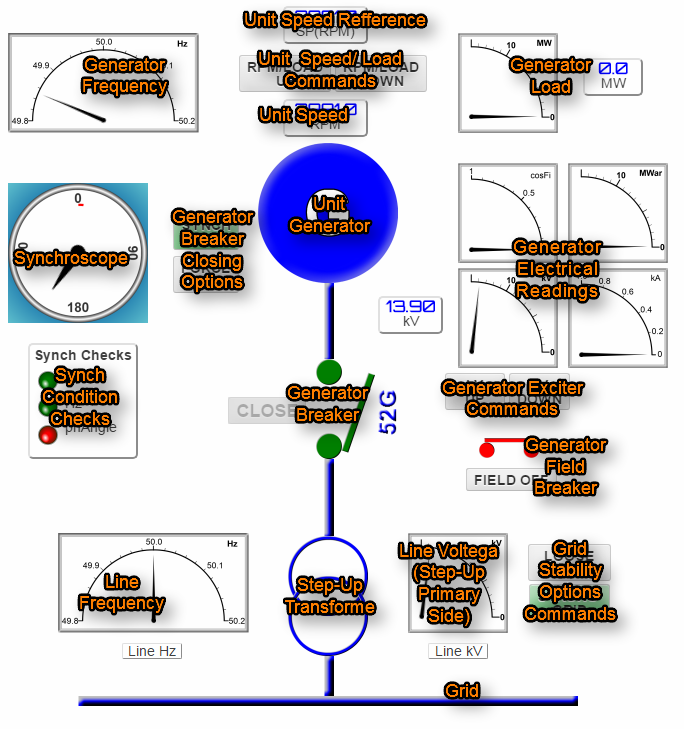Most of the turbines manufactured drive synchronous AC generators. AC generators normally operate together within utility grid. Hence utility grid is a network of AC generators and consumers. Most of public grid generators are of a synchronous type that operate synchronous to each other.
Theoretically the smallest possible grid is a network of two generators only. However, as far the synchronous operation is concerned the same rules apply to all the public grids in the world.
Before any generator is brought into service it needs to be synchronized to grid. Connecting a generator to grid without synchronizing could course a serious stress to unit and has a catastrophic failure potential.
Sync Playground simulates unit synchronizing to utility grid.
Synchronize Function is often a part of turbine governor. At my time, before Auto-Synchronisers became available synchronizing were a manual exercise.
Operator needed to aligning generator to grid manually and close the breaker manually. Parameters to be aligned are:
- Generator Voltage against Grid Voltage;
- Generator Hz against Grid Hz;
- Phase angle between Gen HZ and Grid Hz.
These days Auto-Synchroniser does it all automatically. Operator just push a button and wait for the breaker to get closed. Most of today’s operators (and some engineers) are not aware of what is actually happening ones they push the button.
Synch Playground brings a kind of semi-automatic synchronizing that allows user to follow and understand what is happening.
 The page emulates unit electrical panel. It has all the instruments and switches that were normally installed there at my time. Today electrical panel it just one of unit HMI screens.
The page emulates unit electrical panel. It has all the instruments and switches that were normally installed there at my time. Today electrical panel it just one of unit HMI screens.
The Synch Playground generator is approximately of 12.5MVA at 13.8kV. It has a rudimentary excitation system and no protection. The turbine is of about 10MW output. It has a basic governor. The grid is a 50Hz one. However, as far synchronizing the same rules apply to all the grids, all the generator sizes and all the turbine types.
All the page items are quite explanatory by itself however, they are all marked at the image to the right.
The generator breaker is called 52G. There are two Generator Breaker Closing Options. They are SYNCH and FORCE.
FORCE selected makes 52G CLOSE switch available at all times. User can close the breaker without synchronizing to see what happens. Such a switch exists in real world as well. It is normally called Dead-bus switch. However, it is heavily interlocked against many checks as closing it inappropriately can cause a serious harm to unit.
Page opening comes with SYNCH option already selected. 52G CLOSE switch is grayed. It becomes available ones all the three parameters are aligned. The generator kV and Hz are initially set to match the grid ones. User needs to align the phase angle only. To do so needs to manipulate Unit Speed/Load Commands. For the phase to be aligned the Synchroscope needle has to come into a 0–7deg range from the 0deg direction and stay there for at least 1 second. In the real world this condition is a bit looser however, it is left here as more strict just for a sake of having fun reaching there. The Synchroscope becomes active ones the first two checks are achieved.
Grid Stability Options Commands brings two options as far grid stiffness is concerned. Page opening has STRONG GRID already preselected. It keeps the grid frequency at 50Hz and the Voltage at 13.8kV. LOOSE GRID selected brings slight variations in both Hz and kV.
Drop me a note if you have any issues or questions about the subject.
